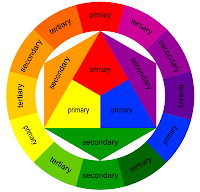In the colour wheel we can see that the red-orange pole is the warmest and the blue-green in the coldest, however the line between what is cold and what is warm can become ambiguous as although the two opposite pole are warm and cold the hues in between them can either be cold or warm as they are contrasted with warm and cold tones.
Cold-warm property is also often described as opposites:
- cold - warm
- shadow - sun
- transparent - opaque
- sedative - stimulant
- rare - dense
- airy - earthy
- far - near
- light - heavy
- wet - dry
The cold and warm contrast between colour is very versatile as it can also suggest distance e.g. in landscapes as distant objects can seem colder due to the constant air around.
Itten mentioned using a 12-hue colour circle in order to successfully achieve a cold-warm modulation e.g. doing red-orange, orange, yellow-orange, red and red-violet, blue-green, green, yellow-green, blue, blue-green and blue-violet. If a full chromatic scale is to be done it can only be successful is all the tones are of the same brilliance otherwise there will be a noticeable light-dark contrast which can affect the chromatic gradation.

No comments:
Post a Comment